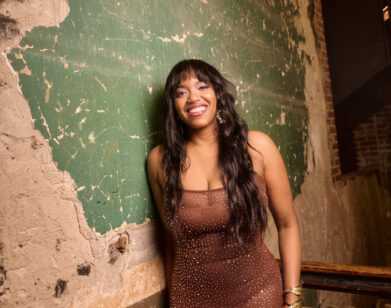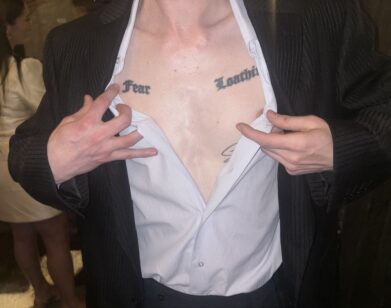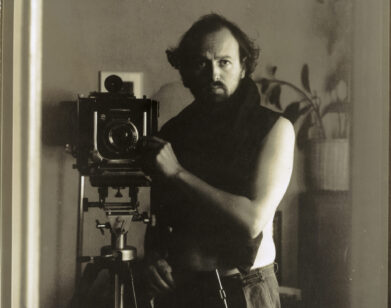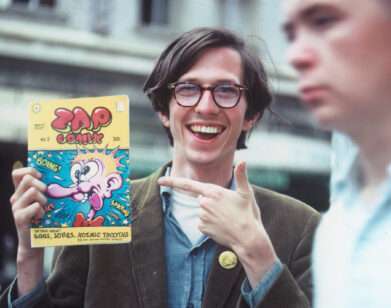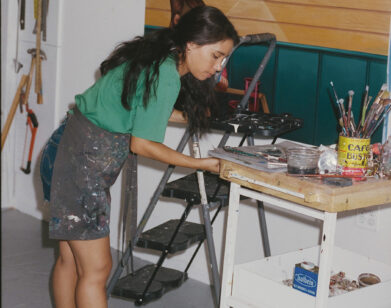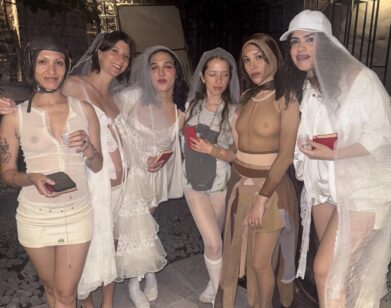Björn Braun’s Birds
Born and raised in East Berlin, one might think that politics greatly influence the artist Björn Braun. Rather than focusing on or even addressing the political upheaval experienced during his childhood and formative years, however, Braun’s work relies on nature and its often sublime, yet sometimes arresting qualities. In his current show “New Towns” at Boesky East in New York, Braun presents a series of egg cartons made entirely from birds’ nests—some even housing eggs found in the original nests. These delicate and sized-to-scale sculptures rest on the floor, while landscape paintings, which were bought at thrift stores and flea markets, that have been recast in aluminum hang on the walls. Above the entrance, Braun replaced glass with bricks made of birdseed in hopes that animals will eat away, eventually entering the gallery itself.
Braun, who graduated from the Academy of Fine Arts in Karlsruhe in 2007, has always been intrigued by the existence of animals in urban environments. He first began making his own birds nests, but quickly transitioned to finding abandoned nests in trees, purchasing them on eBay (they usually cost between 5 and 15 Euro), and receiving them as gifts from friends.
Just before the opening of “New Towns,” which marks Braun’s first solo show outside of Europe, we met with the artist at Boesky East. It became clear that although his grid-like ground layout of egg cartons might evoke notions of Carl Andre, it’s really just about the animals.
EMILY MCDERMOTT: Can you tell me about your process? I’m curious, because you used to make actual bird’s nest sculptures and now they’re compressed into egg cartons.
BJÖRN BRAUN: Every section of the carton is one bird’s nest. The colors depend on how much dirt is in them. I cook them for a very long time and shred them using a food processor. I built a negative form out of silicon, and when I have this paper maché-like consistency—I mix water, bookbinder glue, and wood glue—I press it into the silicon. In some of the nests there were eggs, so then they’re placed into that section of the nest.
MCDERMOTT: What about the titles? Each piece and the exhibition’s title clearly reference architecture.
BRAUN: Because it looks very mathematical, I thought of planned cities, when you see a city from an airplane, or maps. So I wanted to have a somewhat mathematical title. One piece is made of 13 nests and two eggs, so it’s called 13 : 2 : 1. I also wanted to have an English title and my English is not so perfect. In German, it’s Plan Stadt, when someone is planning the city, and these were also very planned. I had to look at how much material each nest would give me, so it was, in a way, like planning a city. I thought that was the easiest title. I didn’t want it to have too much of a poetic title, either.
I’m a very big fan of birds and nests. I’m also interested in landscapes and architecture. I’m interested in the gap between nature and industrial things. I thought that a nest and the egg carton have something together, even if it’s a bit absurd.
MCDERMOTT: It’s a direct conversation about the natural world being processed…
BRAUN: Yes, and also having this amorphous form to make into a very industrial, clean form.
MCDERMOTT: How did you first become interested in birds?
BRAUN: It was when I was in the studium. I started trying to build birds’ nests by myself. I don’t know why; it was a bit stupid but I did it, and then I realized, “Okay, maybe it’s stupid to do it when birds do it.” Maybe it’s also a very psychological question, because in dreams, birds are very present, but I don’t know the meaning, so I cannot answer the question.
I also do works with wild boars and bees. I cannot tell why—I’ve never lived in a landscape; I was born in Berlin and still live there. So it’s a bit strange. I’m also very interested in when these animals come to Berlin and find their habitats.
MCDERMOTT: What keeps you in Berlin? Have you ever wanted to leave?
BRAUN: I was studying in Karlsruhe, in the middle of Germany. It’s a very small town. After studium, I thought, “What do you want?” I come from Berlin—I love it and I hate it—but I went back. It inspires me, these animals that are typical in Berlin. In the forests around Berlin we also have eagles. Sometimes you see papagei [parrots]. This interests me.
MCDERMOTT: What’s one of the strangest encounters you’ve experienced with animals in the city?
BRAUN: The strangest thing was a wild boar. In Germany, they are very dangerous. People have died from them. A friend of mine was on a lake. Next to him was a family and the young kid was looking at my friend, or so he thought. But in the end, this young boy said, “Dog!” My friend turned around and the wild boar was standing next to him. They come into areas where human beings are. I like this very much. I think you also have this here, no?
MCDERMOTT: Not with animals like wild boars. You hardly even see squirrels.
BRAUN: We have many in Berlin! You can sit on a bench with nuts and they come to your hand—very sweet.
MCDERMOTT: I want to talk about your landscape paintings, too. Did you find them all at thrift stores?
BRAUN: And flea markets, eBay, and so on. They are landscape paintings and I had them recast in aluminum. The colors are taken away and you only see the cast of the brushstrokes. From that, you might think of a landscape.
MCDERMOTT: Why aluminum?
BRAUN: I first thought bronze, but in Germany it’s very much for sculpture. I didn’t want it to be too much like a sculpture. I wanted to make it a bit lighter. The problem with bronze, also, is that when you cast it, you have to polish it. I wanted to keep the texture.
MCDERMOTT: How do you choose the paintings underneath? Do you select anything with texture that’s a landscape?
BRAUN: No, no. When it’s too badly painted, it looks like shit. It should be well painted. At the beginning, a landscape or a painting also has an aura because of colors. I wanted to see if they still have these auras when you don’t see the colors.
MCDERMOTT: Growing up, how did you first become interested in art?
BRAUN: The first time I was in a museum I was 17; I was never interested in art, but I went to Villa Merkel [Städtische Galerie] and it influenced me. There was an exhibition of Mark Dion, and he also works with nature. I was doing lots of sports but then I had many injuries, so I was not allowed to do them anymore. I was a bit bored. There was the time, when I was 25 or something and thought, “What are you doing in life?!” So I made some drawings, I applied to art school, and they said yes. Then I started! Maybe it was a bit of a misunderstanding. But I’m happy. It’s good.
MCDERMOTT: What did your parents think when you decided you were going to art school?
BRAUN: I was not brought up like, “You have to do this or that.” I did what I wanted and they were like, “Okay.” I don’t come from a family where art has something to do with life. It’s very far away from them, what I do. But my mother says she likes it! Even if she doesn’t understand it.
MCDERMOTT: When you started studying art, what led you in this sculptural direction?
BRAUN: I like Marcel Boodthaers, a Belgian artist, very much. He’s very intellectual; when I’m honest, I don’t understand it, but from my gut feeling, I thought, “Okay, I can do something with this.” I then started making very, very little landscape drawings with a magnifying glass. Then I started building birds’ nests by myself, but I didn’t know what to do with them.
MCDERMOTT: This piece above the door is bricks made from birdseed. What was the starting point for that piece?
BRAUN: Three years ago, I made an artwork in my German gallery also with birdfeed and a window, but it wasn’t in bricks like it is here. I like imagining that animals or birds come into architecture. I like when they come in, because there’s something uncontrollable.
MCDERMOTT: It’s interesting how you make uncontrollable things so controlled in your work. Do you have any pets?
BRAUN: Yes, I have two finches. They also make artworks for me. I give them materials and they build it. This is also, in a way, uncontrollable, because it’s a question of if they have aesthetic feelings. I give them materials and they choose what they want.
MCDERMOTT: Outside of animals, nature, and architecture, where do you find inspiration?
BRAUN: Nowhere.
“NEW TOWNS” IS ON VIEW AT BOESKY EAST UNTIL DECEMBER 20.


